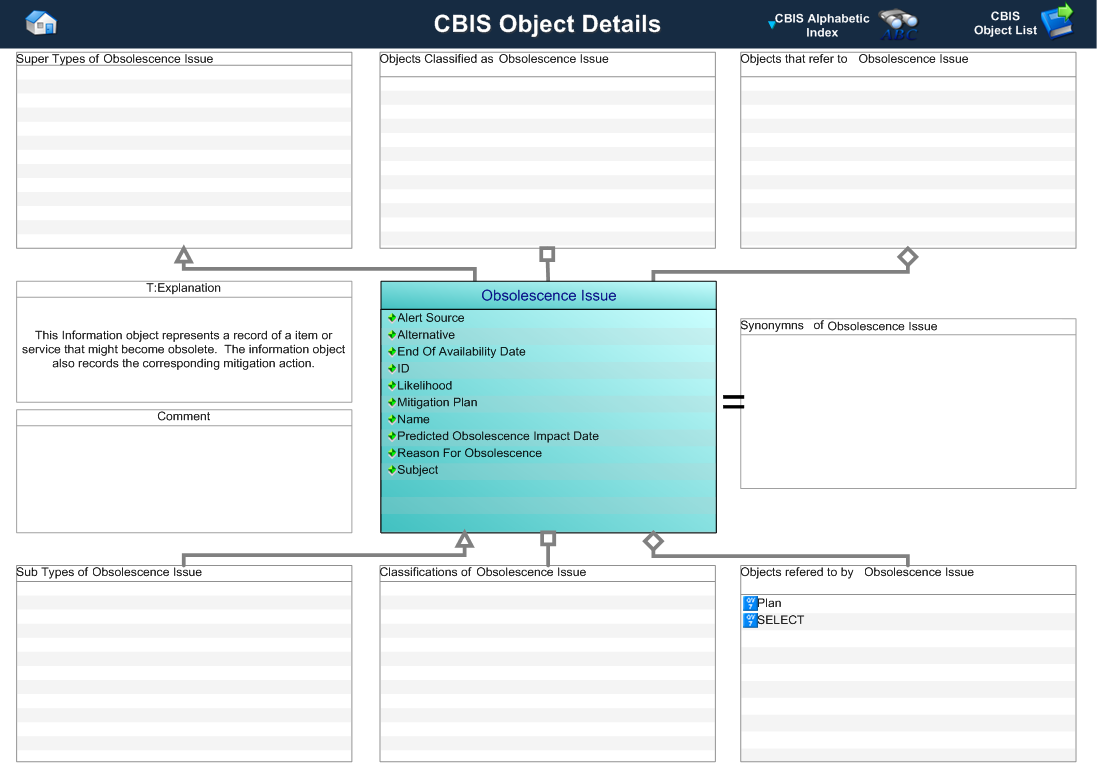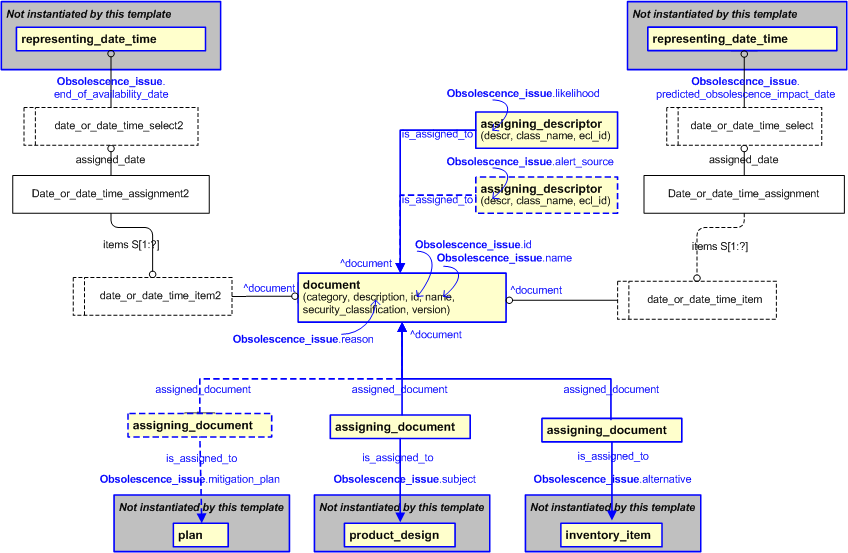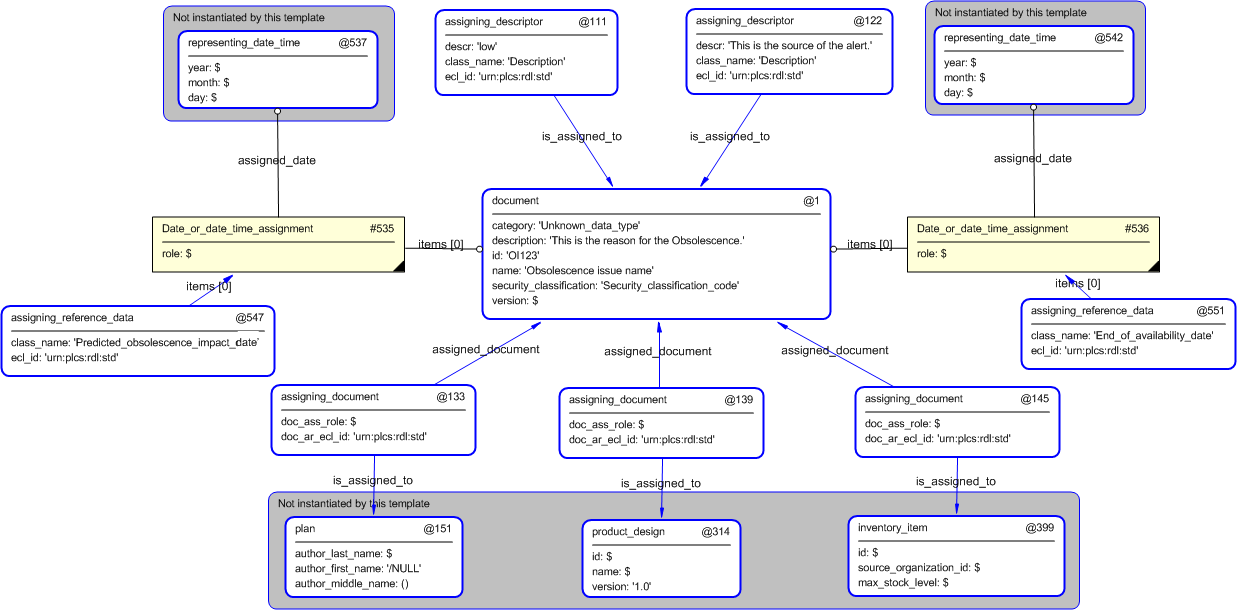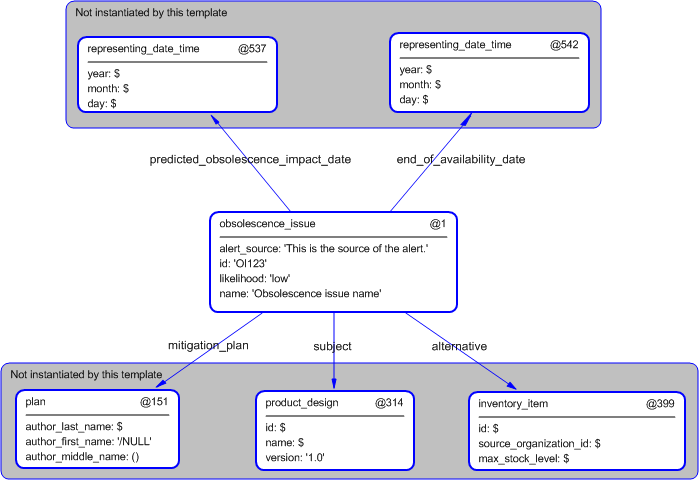Template:— obsolescence_issue (obslscnce_iss)
Context:— UK_Defence |
Date: 2010/03/15 14:46:04
Revision: 1.8
|
This section specifies the template obsolescence_issue.
NOTE
The template has been defined in the context of
UK_Defence.
Refer to the business context for details of related templates.
NOTE
An explanation of a template and the associated instantiation path is
provided in the
Template overview
section.
This template describes how to represent the concept of an obsolescence_issue in terms of PLCS model elements (templates,
entities, and reference data).
A fleet is a named collection of products that are managed as a whole to meet an operational requirement.
This information object represents a named collection of products that are managed as a whole to meet an operational
requirement.
Figure 1 — A MOOD Business Architect representation of the Business Object: Obsolescence Issue
The attributes of the Obsolescence Issue object are tabled below.
|
Attribute name
|
Attribute description
|
Attribute type
|
Optionality
|
| Alert Source |
This is an identification of the source of the obscolescence alert for the product or service. |
intrinsic |
optional |
| Alternative |
This is a reference to the alternative product design or service that might be used as an alternative. |
Relationship to Product Design, Service, Inventory Item or Item of Supply |
Mandatory |
| End of Availability Date |
This is the latest date the item subject to obsolence will be available. |
intrinsic |
Mandatory |
| ID |
This is the identifier of the obsolescence issue. |
intrinsic |
Mandatory |
| Identifier.id |
This is the value of the id attribute of the Identifier applied to the obsolescence issue. |
intrinsic |
Mandatory |
| Likelihood |
This is the probability of the obsolescence occuring. |
intrinsic |
Mandatory |
| Mitigation Plan |
This is the reference to the mitigation plan for the obsolescence issue - if one is created for all impacts on all PSE Constituents.
If separate mitigation plans are created for each PSE, these are captured by the Obsolescence Impact object.
|
Relationship to Plan |
Optional |
| Name |
This is the name of the obsolecence issue. |
intrinsic |
Mandatory |
| Predicted Obsolescence Impact Date |
This is the predicted date the obsolescence will have an impact on the capability. |
intrinsic |
Mandatory |
| Reason For Obsolescence |
This is the stated reason for obsolescence. |
intrinsic |
Optional |
| Subject |
This is a reference to the product design or service that is subject to obsolescence. |
Relationship to Product Design or Service |
Mandatory |
Table 1 — Obsolescence Issue attribute details
The EXPRESS-G diagram in
Figure
2
shows the templates and EXPRESS entities that are required
to represent the template
"obsolescence_issue".
The text highlighted in blue shows the template parameters.
Figure 2 — An EXPRESS-G representation of the Information model for obsolescence_issue
The graphic for the template to be used in other EXPRESS-G diagrams
is shown in Figure
3
below.
Figure 3 — The graphical representation of the obsolescence_issue template
The following input parameters are defined for this template:
The source of the obsolescence alert.
This is the reference to the product design or service that might be used as an alternative.
This is the latest date the item subject to obsolence will be available.
The identifier of the obsolescence issue.
The probability of the obsolescence occurring.
This is the reference to the mitigation plan for the obsolescence issue.
The name of the obsolescence issue.
The predicted impact on capability date.
The reason for the obsolescence.
This is the reference to the product design or service that is subject to obsolescence.
The following reference parameters are defined for this template:
Allow the
Document
entity instantiated in this path to be referenced when this template is used.
Note: The
Document
entity can be referenced in a template path by:
%^target = $obsolescence_issue.document%
where
target
is the parameter to which the
Document
is bound.
Allow the
Document_version
entity instantiated in this path to be referenced when this template is used.
%^target = $obsolescence_issue.document_version%
Allow the
Document_definition
entity instantiated in this path to be referenced when this template is used.
%^target = $obsolescence_issue.document_definition%
The instantiation path shown below specifies the entities that are to be
instantiated by the template.
A description of templates and the syntax for the instantiation path is
provided in the
Templates Help/Information section.
-- ID -- name -- [Optional reason] /
document(
author='' category='Unknown_data_type' description=@reason,
id=@id,
name=@name,
releasing_authority='',
security_classification='',
valid_from_date=$,
valid_to_date=$,
version='')/
%^document = $document.document%
%^document_version = $document.document_version%
%^document_definition = $document.document_definition%
-- [optional alert_source] /
assigning_descriptor(
descr=@alert_source,
class_name='Alert_source',
ecl_id='urn:plcs:rdl:uk_defence',
is_assigned_to=^document)/
-- alternative /
assigning_document(
doc_ass_role='Alternative',
doc_ar_ecl_id='urn:plcs:rdl:uk_defence',
assigned_document=^document,
is_assigned_to=@alternative)/
-- relationship to end_of_availability_date Date_or_date_time_assignmentDate_or_date_time_assignment.role = '/IGNORE'
Date_or_date_time_assignment.items ->
^document
Date_or_date_time_assignment.assigned_date ->
@end_of_availability_date%^end_of_availability_date =
Date_or_date_time_assignment%
/
assigning_reference_data(
items=^end_of_availability_date,
class_name='End_of_availability_date',
ecl_id='urn:plcs:rdl:uk_defence')/
-- likelihood /
assigning_descriptor(
descr=@likelihood,
class_name='Likelihood',
ecl_id='urn:plcs:rdl:uk_defence',
is_assigned_to=^document)/
-- [Optional mitigation_plan] /
assigning_document(
doc_ass_role='Mitigation_plan',
doc_ar_ecl_id='urn:plcs:rdl:uk_defence',
assigned_document=^document,
is_assigned_to=@mitigation_plan)/
-- relationship to predicted_obsolescence_impact_date Date_or_date_time_assignmentDate_or_date_time_assignment.role = '/IGNORE'
Date_or_date_time_assignment.items ->
^document
Date_or_date_time_assignment.assigned_date ->
@predicted_obsolescence_impact_date%^predicted_obsolescence_impact_date =
Date_or_date_time_assignment%
/
assigning_reference_data(
items=^predicted_obsolescence_impact_date,
class_name='Predicted_obsolescence_impact_date',
ecl_id='urn:plcs:rdl:uk_defence')/
-- subject /
assigning_document(
doc_ass_role='Obsolescence_issue_subject',
doc_ar_ecl_id='urn:plcs:rdl:uk_defence',
assigned_document=^document,
is_assigned_to=@subject)/
The following entities are instantiated with attributes as specified:
The instance diagram in Figure
4
shows an example of the EXPRESS entities and templates that are instantiated by the template:
/obsolescence_issue(id='OI123', name='Obsolescence issue name', reason_for_obsolescence='This is the reason for the Obsolescence.', alert_source='This is the source of the alert.', end_of_availability_date='@542', alternative='@399', likelihood='low', predicted_obsolescence_impact_date='@537', subject='@314', mitigation_plan='@151')/
(an illustration of the consolidated obsolescence_issue template is shown in
Figure
5 below.)
Figure 4 — Entities instantiated by obsolescence_issue template
The instance diagram in
Figure
5
shows the graphic symbol for the template that is to be
used in other instance diagrams. The example template is:
/obsolescence_issue(id='OI123', name='Obsolescence issue name', reason_for_obsolescence='This is the reason for the Obsolescence.', alert_source='This is the source of the alert.', end_of_availability_date='@542', alternative='@399', likelihood='low', predicted_obsolescence_impact_date='@537', subject='@314', mitigation_plan='@151')/
Figure 5 — Instantiation of obsolescence_issue template
Characterizations
No common characterizations of the template
obsolescence_issue
have been identified. However, the ISO 10303-239 EXPRESS model
may enable other assignments to the entities instantiated by the template.




